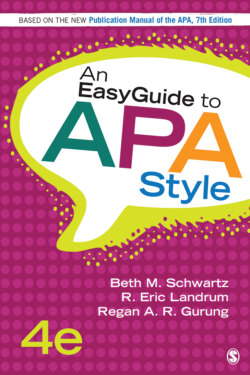Читать книгу An EasyGuide to APA Style - Regan A. R. Gurung - Страница 20
На сайте Литреса книга снята с продажи.
Clear and Succinct Writing: Using Your Scholarly Voice
ОглавлениеAs with any type or genre of writing, it takes both time and practice to get good at it and build your confidence. Scientific writing has its own voice and tone, with the appropriate levels of formality, detachment, and objectivity, and this scholarly writing is written with a different style than is typically used in creative or technical writing. Be sure to avoid slang words, excessive use of first person, gender bias, too many direct quotations, contractions, and inappropriate passive voice. You should also avoid wordiness, especially just for the sake of reaching a mandatory page length. Even with these style rules, scientific writing does not have to be boring. In fact, the better journal articles in psychology are written to tell a good story. Even though the language may not use a conversational tone, this decision is a purposeful one to be clear and concise. Clear communication is the primary objective—to present ideas precisely, with logic and a smooth flow from idea to idea (Knight & Ingersoll, 1996).
In some college student writing assignments, such as composing a term paper or answering an essay question on an exam, you might tend to go on and on, hoping the instructor “finds” the right answer buried somewhere in your prose—this could be called the “kitchen sink” approach. Scientific writing does not share that same strategy. You should always strive to be succinct—concise and to the point. As readers, we appreciate the courtesy of authors who write in this manner; the author does not waste our time with unnecessary words or ideas that clutter the central message. However, as writers, it takes time and practice to acquire this skill; we have designed this book to help you improve as a succinct writer. Knight and Ingersoll (1996) captured the essence of this approach:
Vigorous writing is concise and direct. A sentence should contain no unnecessary words and a paragraph no unnecessary sentences. This does not mean that all sentences and paragraphs should be short or lacking in detail, but that every word is purposeful. (p. 210)
Here’s one more idea to share about writing clearly and succinctly—what about quotations and contractions? If you are going to use direct quotations in your writing, be sure you have noted the exact page or paragraph number from where the quote appeared—the citation might look like (Smith, 2014, p. 712) or (Jones, 2015, para. 7). Prior to completing the assignment, we strongly recommend that you consult with the person grading the assignment to determine their preferences about direct quotations. Some instructors might welcome the use of an occasional quote, whereas others might discourage it completely. Since your results may vary, why not inquire first?
Now, about contractions—we don’t recommend them for formal APA-Style writing. (In this sentence, the word “don’t” is a contraction—the shortened form of “do not.”) Contractions connote a more informal style of writing (as your authors have aspired to in this user-friendly EasyGuide), but if we were writing for a more formal outlet (such as a journal or an academic book), we would not use contractions. It’s about formality. In addition to using words properly, you’ll want to use the right words in the right places—that is, avoiding those commonly confused words.
